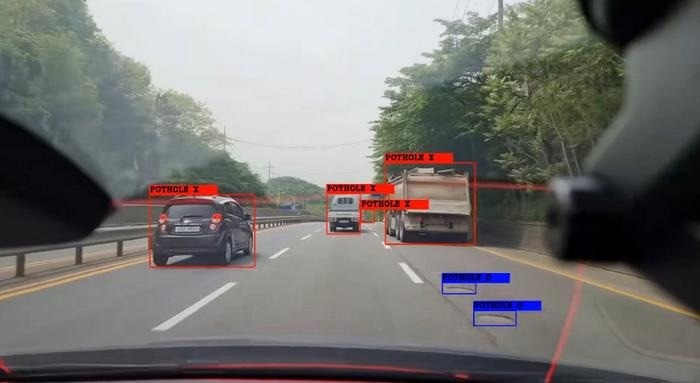A “Road Pothole Filtering Program” to establish an emergency road restoration system for regular pothole occurrences has been developed by the Korea Institute of Civil Engineering and Building Technology (KICT, President Kim Byung-Suk).

Pothole inspection screen using artificial intelligence pothole filtering program (blue: pothole correct, red: not pothole). Image Credit: Korea Institute of Civil Engineering and Building Technology (KICT)
Generally specified as “the landmine of the road,” potholes are considered a road damage phenomenon in which parts of the asphalt sink into bowl-like depressions. Potholes happen when a considerable amount of rainwater infiltrates the road surface, thereby weakening the ground below and causing the asphalt pavement to fall under the weight of passing vehicles.
Potholes have become more prevalent due to abnormal weather conditions like heavy rainfall and increased snowfall resulting from recent global warming. These road imperfections create problems for both vehicles and pedestrians, contributing to various degrees of traffic accidents.
The KICT research group, headed by Dr. Moonsup Lee, has come up with a new pothole filtering program. The server-based pothole filtering program, which will be the addition to the Public Data Management System (PDMS), has been developed to review the main pothole information that has been detected by the pothole detection program.
The pothole detection program, managed by the Land Management Office under the Ministry of Land, Infrastructure and Transport, is a mobile-based application utilized for pothole detection.
However, high-specification programs could not run on mobile devices as a result of limitations in device performance. Consequently, for initially detected pothole information, it is essential to implement a system that filters objects resembling potholes, like lane markings, shadows, and tires.
An artificial intelligence algorithm has been developed and trained by the research group to exclude objects apart from potholes from the main pothole information that has been sent to the server, thereby efficiently choosing the real ones.
As soon as the training of the pothole filtering program has been done, it proceeds to inspect the main pothole information. Its algorithm was developed to utilize the inspected potholes and other objects as training data for additional program enhancement.
Dr. Lee’s research group has recognized a system utilizing the developed pothole filtering program to automatically transmit confirmed pothole information to the road maintenance personnel of the Land Management Office every 3 hours.
We anticipate that the newly developed system will reduce the processing time of emergency pothole restoration on roads.
Dr. Moonsup Lee, Study Lead Researcher, National Research Council of Science and Technology